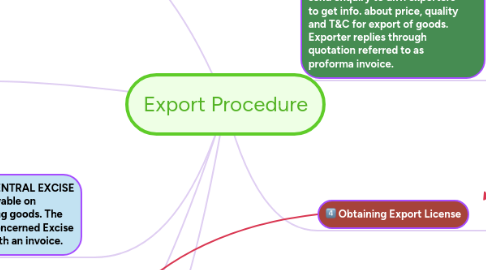Export Procedure
da Shubham Sagar


1. Pre-shipment inspection : Govt. has taken steps to ensure only good quality products are exported. It's passed EXPORT QUALITY CONTROL AND INSPECTION ACT, 1963.
2. Excise clearance : As per CENTRAL EXCISE TARIFF ACT, excise duty is payable on materials used in manufacturing goods. The exporter has to apply to the concerned Excise Commissioner in the region with an invoice.
2.1. Obtaining certificate of origin : Some importing countries provide tariff concessions or other exemptions to the goods coming from a particular country. To avail such benefits, importer may ask the exporter to send a certificate of origin.
2.2. Reservation of shipping space : Exporting firm applies to the shipping company for provision of shipping space. It has to specify the types of goods to be exported, probable date of shipment and port of destination.
3. Obtaining pre-shipment finance : Exporter approaches his banker for obtaining pre-shipment finance to undertake export production.
3.1. Production or procurement of goods : Exporter gets the goods ready as per specifications of the importer. It may produce the goods itself or procure them.
4. 11. Packing and Forwarding : Goods are packed and marked with necessary details such as name and address of the importer, gross and net weight, port of shipment and destination etc.
4.1. 12. Insurance of Goods
4.2. 13. Customs Clearance
5. 14. Obtaining mates receipt
5.1. 15. Payment of freight and insurance of bill of lading
5.2. 16. Preparation of invoice
5.3. 17. Securing payment
6. Receipts of enquiry and sending quotations : Prospective buyer send enquiry to diff. exporters to get info. about price, quality and T&C for export of goods. Exporter replies through quotation referred to as proforma invoice.
6.1. Goal 2
6.2. Goal 3
6.3. Receipt of order or indent : Importer places an order for the goods to be despatched. Also known as indent, it contains info. about the goods ordered, price, delivery terms etc.
6.3.1. Assessing Importer's Credit Worthiness : Exporter enquires about credit-worthiness of importer to assess the risks of non-payment by the importer once goods reach import destination. Exporter demands letter of credit from importer.

